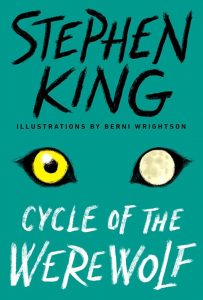The Stephen King Project – Cycle of the Werewolf (1983)
About the project
I will be reading all of Stephen King’s books in order of publication (with the exception of The Dark Tower series which I will read together, at the end of this adventure) and writing a review of each. I’ll be looking at the recurring themes, the tricks he likes to use, the way he develops character and the way that his craft has evolved in the 44 years since Carrie was first published.
This is one of the King books that I had never read before the start of this project. In fact, I don’t think I had even registered that it existed, although no doubt I had seen it listed in the front of other books at some point. Either way, I knew next to nothing about it, so when I ordered a paperback copy and it came through the door, I was shocked by its small size. King isn’t exactly known for his brevity, after all. Through the years, I have come to love the length of his books as much as anything else.
 Cycle of the Werewolf is a novella-sized book, which was the first surprise. The second was that it is packed full of wonderful illustrations. Intrigued, I did a little research and found out that this tale has a particularly interesting origin.
Cycle of the Werewolf is a novella-sized book, which was the first surprise. The second was that it is packed full of wonderful illustrations. Intrigued, I did a little research and found out that this tale has a particularly interesting origin.
At the World Fantasy Convention in 1979, Stephen King was approached by Christopher Zavista, from Land of Enchantment Press. He asked if King would consider writing twelve linked vignettes to be accompanied by illustrations from Berni Wrightson and produced as a calendar. King was intrigued (and drunk) and agreed straight away. The idea of monthly divisions led him to the cycle of the moon and from there, it wasn’t much of a jump to the titular werewolf. But the vignette style didn’t work for King and he really struggled to write the sections – until he hit July, grabbed onto the story and let go of the wordcount.
He got in touch with Zavista who was more than happy to end up with a short, illustrated book rather than the agreed-upon calendar. Who wouldn’t be?
The book itself showcases King’s ability to sketch in a whole town despite the small space. I love how he manages to establish character with a few short sentences. There’s nothing particularly original about the werewolf itself but I was delighted with how he is eventually brought down. Marty Coslaw, the young hero of the story, reminded me quite a lot of Mark Petrie in ‘Salem’s Lot. I do enjoy the trope of the precocious child and the slightly outsider adult who appreciates them.
There’s not too much I can say about the story itself without spoilers but it’s well-paced, fun and I didn’t want to put it down. It’s an attractive book with some powerful artwork and although it wouldn’t make it into my top-ten King books, I still enjoyed it.

Not surprised you hadn’t read it – it seemed to become a sort of lost classic there for a long time. I bought the original trade paperback with the full-color illustrations when it first came out (near the height of my SK fandom), but then never saw it on bookshelves again for ages.